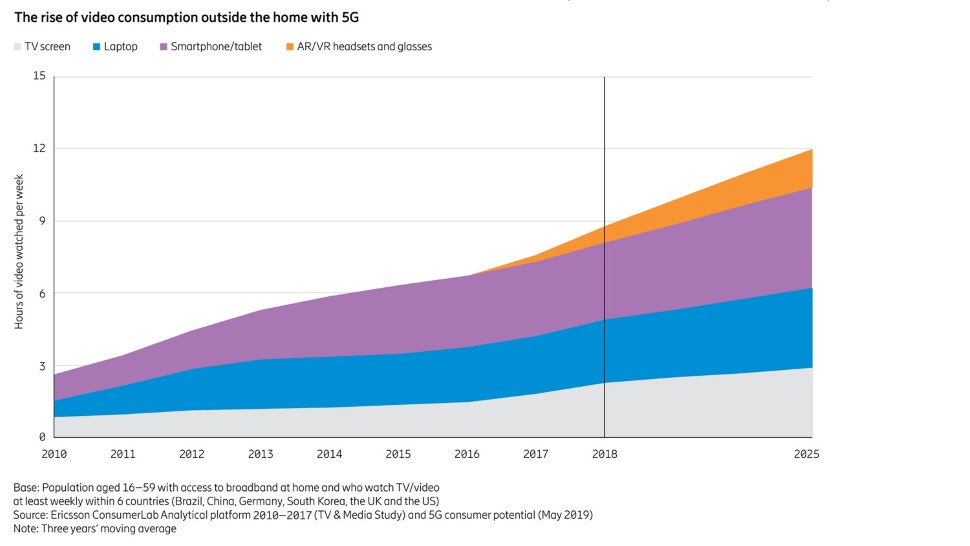5G: Don’t Count on Smartphones to Drive Early Success
The initial success of 5G will be driven by fixed wireless services rather than mobile apps, as nearly half of consumers believe that current smartphone designs will not be able to take advantage of the standard’s ultra-fast speeds. This is prompting most consumers to look first at using 5G to replace home wireless broadband and cable TV. In addition, many believe that 5G will mean that smartphones could be replaced by augmented reality glasses within the next five years.

These are some of the conclusions drawn by Ericsson in its new “5G Consumer Potential” report that focuses on “busting the myths around the value of 5G for consumers.” The report is the result of more than 35,000 online interviews conducted by Ericsson Consumer & Industry Lab on consumers aged 15-69 in 22 countries, as well as interviews with industry experts.
The report predicts worldwide adoption of 5G will come in three phases:
- Home wireless broadband and premium smartphone experiences that allow content to be downloaded in seconds are expected to go mainstream within one year of 5G launch;
- Moving away from traditional cable TV and opting for a UHD TV service (5G TV) bundled with 5G home wireless broadband (this was the most popular on consumer’s wishlist), and
- The ability to use 5G hot zone services that offer ultra-high speeds and reliability in demanding locations like airports, shopping streets and office spaces.
According to the report, a quarter of households (one-third in the U.S.) have become “hyperconnected” with more than 10 connected devices, covering smartphones, tablets, PCs, smart TVs, voice controlled devices and VR headsets. Households worldwide average six connected screens and one third expect to add at least one more screen within the next year.
Consumer dissatisfaction over slower than advertised broadband speeds and inadequate TV bundles is prompting one-third of fixed home broadband users to look for alternate providers, Ericsson says. When offered the prospect of 5G home wireless broadband, 8 of 10 who say they want to switch would consider supplementing or outright replacing their service.
"The market is established and home 4G broadband connections are under pressure,” said Jan Trionow, CEO of Austrian-based telco Three. “Capacity is needed to continue the business, improve connectivity and to do this on a nationwide scale.”
The attraction of 5G services vary geographically, according to the report, with U.S. and U.K. consumers preferring to attach 5G TV services to their plan; Chinese preferring a 5G “smart home;” Koreans advocating shopping in VR with tactile feedback and Saudi Arabian consumers preferring immersive.
Get the TV Tech Newsletter
The professional video industry's #1 source for news, trends and product and tech information. Sign up below.
The death of the smartphone in its current form factor has been predicted for several years now and consumers seem to have paid attention, according to Ericsson. Half of those surveyed believe that by 2025, smartphones will still exist, but that many others will be using 5G-enabled “smart glasses” that use augmented reality to display and manipulate much more data.
"The smartphone will be dead in five years' time," predicts Johan Hagegård at IMRSV, an AR/VR innovation house. "I will instead have smart glasses in front of me all the time." Matt Stagg of EE agrees with this bold prediction: "The smartphone as we see it now does not have anything on it. It can't take advantage of 5G, such as holographic apps, in the longer term."
Average world smartphone usage in 2018 stood at 5.6 GB per month and is expected to increase to 21 GB per month in 2024, an increase of roughly 4x from today's usage, according to Ericsson. And with the emergence of 5G, consumers also expect to vastly increase their use of video, including viewing video on holographic displays.
Currently video consumes 60 percent of worldwide data usage and half of the consumers surveyed said they expect 5G will spur them to watch more video content in 4K.
In terms of affordability, on average, smartphone users said they would be willing to pay a premium of 20 percent over and above what they pay today for the benefits of 5G. However, half of all early adopters who are familiar with 5G's promises could pay as much as 32 percent more than they do today, according to Ericsson.
“Consumers' willingness to pay should be interpreted as a stronger measure of their interest in 5G-enabled services," Ericsson said. "However, it should not be interpreted as a prediction of how much they will pay for a certain service.”
Tom has covered the broadcast technology market for the past 25 years, including three years handling member communications for the National Association of Broadcasters followed by a year as editor of Video Technology News and DTV Business executive newsletters for Phillips Publishing. In 1999 he launched digitalbroadcasting.com for internet B2B portal Verticalnet. He is also a charter member of the CTA's Academy of Digital TV Pioneers. Since 2001, he has been editor-in-chief of TV Tech (www.tvtech.com), the leading source of news and information on broadcast and related media technology and is a frequent contributor and moderator to the brand’s Tech Leadership events.

